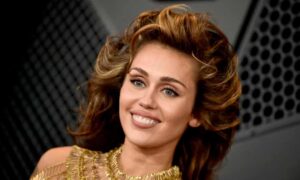
After Miley Cyrus won her first Grammy Awards this month, she took to social media to “personally thank my hair” – a 1970s coif that made the case for dangerous quantities of hairspray, back brushing, Velcro rollers and hairpins. It drew on her southern roots, where a common saying is something along the lines of: “The higher the hair, the closer to heaven – so ‘tease it to Jesus’.”
Cyrus isn’t alone. Big hair is having a resurgence, from Julianne Moore in The Cut magazine to Julia Roberts on the cover of Vogue. Doll-like models wore coloured wigs inspired by The Supremes at the Marc Jacobs’ show in New York earlier this month, to celebrate his brand’s 40th anniversary. For the recent Schiaparelli couture show in Paris, legendary hair stylist Guido Palau teased model Kendall Jenner’s hair into a bouffant, which was accessorised with a red strapless minidress made from fingernails.
Larger-than-life hair has been dominating the screen, too: from Cailee Spaeny’s gravity-defying ’do in Sofia Coppola’s Priscilla; to Amy Winehouse’s back-brushed beehive in Back to Black, a biopic about her life coming in April. Then there is Emma Stone’s four feet of extensions that made for a dramatic hair moment in Poor Things. Finally, a remake of 2004’s favourite film, Mean Girls, has sent TikTok crazy for a line from the original: “That’s why her hair is so big. It’s full of secrets.”
In fact, “big hair” has more than 950 million searches on the platform, pulling up references to Cindy Crawford’s 90s blowout, supersized natural hair, and the hot-off-the-tongs styles of The Sopranos’ leading ladies, Carmela and Adriana.
Big hair is free and rebellious. It is the antithesis of the clean girl aesthetic that’s dominated the 2020s so far, where quiet luxury, natural makeup and hair that’s scraped and straightened has reigned supreme.
In 2024, says Palau, “it feels subversive to do big hair. At one time, it was the epitome of glamour and power,” but now it’s rare to see a woman with over coiffed hair, which makes “it shocking to see”.
In the 50s and 60s, by contrast, “women did their hair like that every day and that was considered the height of how women should present themselves”. Today, instead of an expectation, it can be seen as an act of self-indulgence to style your hair that way, rather than in the ubiquitous messy bun, the symbol of our time-poor society. “To see a woman that has spent that much time, it feels like a very in-your-face hairdo,” says Palau. “And I love it.”
